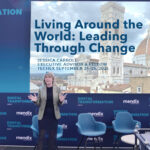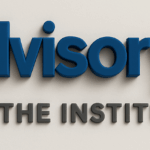Listening to a recent interview with a visionary leader in the health sector in New Zealand, Dr Lester Levy1, I thought about the importance of leadership and the type of thinking leaders bring to actualize digital-era opportunities. (This article was approved for publication by Dr Levy.)
Digital Optimisation
What is the thinking needed in a world where consumer demands are infinite and resources are limited? How do you mine every last available resource and get the most of what’s possible?
“I am an optimist” Levy says. “Disaster speaks for itself; opportunity needs an advocate.”
He contrasts the thinking focused on narrowing the performance gap from that required to close a possibility gap in a world with genomic (personalised) medicine, nanotechnology, big data and the cloud. The health possibilities are potentially infinite. Not only will it take a vision of what’s possible, but choices about what’s best. Simply increasing current activity (throughput) – doing more of the same – won’t cut it. You need a strong and determined will, alongside a vision, to push through barriers synonymous with organizational silos keeping us locked into outdated operating models.
Thought Leadership
A common theme is evident among thought leaders in seemingly unconnected fields. Kaspersky CEO, Eugene Kaspersky, commented recently that cyber security is not at risk because of a lack of technology but rather the lack of WILL: too many national silos and too little cross-border collaboration.
Levy echoes this in asserting that organisation leaders are notoriously poor at collaboration. He cites an example of a life-changing outcome for a stroke victim who returned home to live a normal life due to collaborative healthcare delivery. This is possible where multi-site demands for service are channelled through a single site of care so that volumes accelerate experience and expertise. This has significantly improved health outcomes.
This is just one example of how collaboration leads to best outcomes from available resources through a focus on what the whole system can offer rather than artificially-isolated parts. This means sharing, opening up, breaking down walls and putting ego to one side. (My words, not his.)
Dr David Agus (author of The End of Illness, a title provided by the late Steve Jobs) challenges traditional approaches to healthcare and is similarly excited by digital health possibilities. He shows how an app on his iPhone measures his heart’s electrical activity through his fingertips. Another App (costing 79p) measures his breathing and pulse rate by filming his face. “I can build up a record and email it to my doctor,” he says. “It’s a new world.”2
Digital Thinking
The interview with Dr Levy reveals the type of thinking required to make the absolute most of resources currently invested in healthcare delivery. This thinking is consistent with that required to get the best return from any investment in service delivery, no matter what the type of organization, especially in digital times.
These themes, featured below, are consistent with systems thinking, lean thinking, positive psychology and cognitive science and apply across the whole spectrum of commercial and public sector activity.
Test this: how many of these ways of thinking when applied to your sector, organisation and/or department would result in significantly better outcomes?
Key thought drivers of success (summarised from the above-mentioned interview):
- Less linear thinking (given the complexity of dynamic systems) and more holistic thinking that takes an end-to-end (aligned) view of service delivery.
- Fewer restructures (which distract from the task at hand, consume scarce resources and lower morale) and more collaboration. People work together where and how needed to concentrate expertise and produce the best collective response to demands (in spite of formal structures).
- Less focus on budgets and more focus on innovative ways to deliver better outcomes. E.g. a ‘factory’/assembly line view aims to increase throughput; different thinking questions the very activity. (Levy quotes research showing the placebo effect delivering the same pain relief as costly and invasive surgical procedures.)
- More compassion (in health delivery) and less focus on completion of procedures as the achievement. Experience management accounts for patient (customer) and staff mental and emotional wellbeing in assessing outcome quality. (An interview with Dr Jean Watson reveals non-medical, traditional nursing, methods for better health outcomes.3)
- More purpose-driven work. We know from brain research that people fuelled by a positive and meaningful purpose are not only healthier themselves, but their brain is more innovative and resourceful.
- Less focus on getting more money and more focus on what we currently use the budget for.
Design Thinking
When designing our organizations – our models of service delivery – we’d do well to heed Levy’s distinction between anatomy and physiology: “I could show you a human body where the anatomy is perfect – all the organs are where they should be but the person is dead because they no longer have a physiology that works.” Many of us know organizations that fit that description.
The thought leaders in this article are in effect challenging us to:
- Rewire our thinking and act accordingly
- STOP doing what we know doesn’t add value. Just stop.
- Do different things entirely
- Ensure every (resource-consuming) activity furthers the organisation purpose
- Interrogate organization design: who does what, how and when
- Ask if there isn’t a better way
- Collaborate – break through artificial separations and act to deliver in better ways
Doing more of the same is no longer viable. To capitalise on digital opportunities, we have to stop spending on what is taking us backwards and divert resources to where they count most.
Without each one of us firmly committed to a radical rewire of the top 3 inches, potential gains will be lost. Unrealized opportunity is still waste.
Sources:
1 Dr Lester Levy. Radio NZ Interview: Health’s most powerful appointee. 04 Feb 17. http://www.radionz.co.nz/audio/player?audio_id=201832073.
2 Dr David Agus: “Crunch data to live longer”. The Guardian Today. 6 January 2016. https://www.theguardian.com/society/2016/jan/06/science-medicine-diet-david-agus-longevity-data-health-policy-disease-cure-end-of-illness
3 Dr Jean Watson. Radio NZ interview: “Nursing the way it should be”. 11 Dec 2016. http://www.radionz.co.nz/national/programmes/sunday/audio/201827262/dr-jean-watson-nursing-the-way-it-should-be





